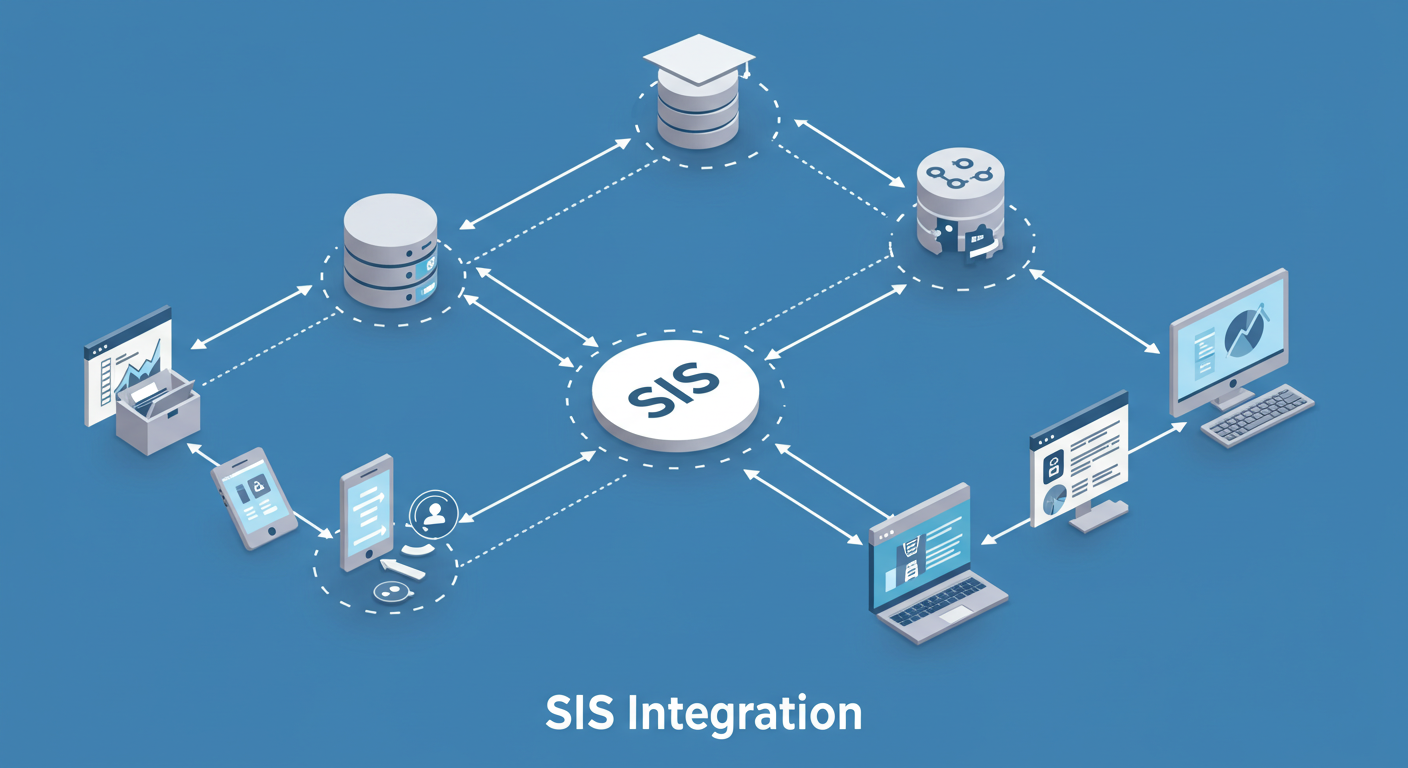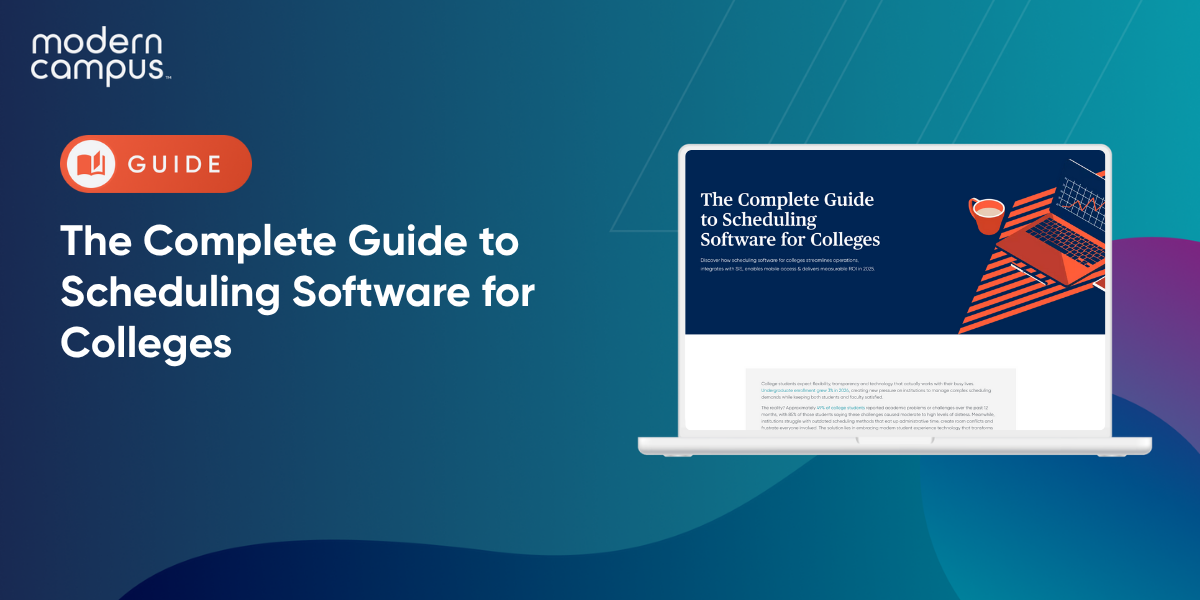College students expect flexibility, transparency and technology that actually works with their busy lives. Undergraduate enrollment grew 3% in 2024, creating new pressure on institutions to manage complex scheduling demands while keeping both students and faculty satisfied.
The reality? Approximately 49% of college students reported academic problems or challenges over the past 12 months, with 85% of those students saying these challenges caused moderate to high levels of distress. Meanwhile, institutions struggle with outdated scheduling methods that eat up administrative time, create room conflicts and frustrate everyone involved. The solution lies in embracing modern student experience technology that transforms chaos into clarity.
This comprehensive guide explores everything you need to know about implementing scheduling software for colleges, from essential features and mobile accessibility to integration strategies and calculating real ROI. This roadmap will help you make informed decisions that benefit students, faculty and your bottom line.
Table of Contents:
Why Scheduling Software for Colleges Matters
Scheduling software for colleges represents a fundamental shift from manual, error-prone processes to intelligent, automated systems that optimize how institutions manage courses, rooms, faculty assignments and student enrollments. It's the central nervous system for your academic operations, coordinating everything from room assignments to faculty preferences while ensuring students can actually get into the classes they need to graduate.
Defining Modern Scheduling Solutions
College scheduling software integrates real-time data from multiple sources, automates conflict detection and provides predictive analytics to help institutions plan ahead. The best systems incorporate artificial intelligence to suggest optimal scheduling patterns based on historical enrollment data, student success metrics and resource utilization rates.
Modern solutions also recognize that scheduling isn't just about avoiding conflicts; it's about creating pathways to student success. Recent higher education trends indicate that institutions are increasingly focusing on competency-based programs and flexible learning formats that require more sophisticated scheduling capabilities than traditional semester-based models.
The Cost of Outdated Scheduling Methods
Legacy scheduling approaches exact a heavy toll on institutions. Manual processes consume significant administrative time each term, not counting the additional hours spent resolving conflicts and making last-minute changes. Faculty satisfaction drops when scheduling doesn't consider their preferences or expertise areas, while students face delayed graduation when required courses aren't available.
When students can't access needed courses, it extends their time to degree completion, reducing institutional throughput and potentially impacting retention rates. Research shows that 73% of students rate their college education quality as good or excellent, but scheduling frustrations can quickly erode that satisfaction.
Key Benefits for Student Success
Effective scheduling software creates a ripple effect of positive outcomes. Students gain visibility into course availability, can more effectively plan their academic paths and spend less time navigating bureaucratic obstacles. Faculty members benefit from schedules that align with their expertise and preferences, leading to more engaging classroom experiences. From an institutional perspective, optimized scheduling improves space utilization, reduces scheduling errors and provides data-driven insights for strategic planning. The result is a more efficient operation that can focus resources on delivering exceptional educational experiences.
Essential Features Every College Scheduling Software Must Have
The most effective college scheduling solutions combine core functionality with advanced features that address the unique complexities of higher education environments.
Student Information System (SIS) Integration
True scheduling software for colleges must seamlessly connect with your existing SIS. Integration creates a unified ecosystem where changes in one system automatically update others. The most successful implementations feature bi-directional integration that allows scheduling decisions to flow back into student records while pulling real-time enrollment data to inform capacity planning.
Look for solutions that can do more than basic file transfers. Real integration means the scheduling system can access custom fields, handle complex course prerequisites and maintain data integrity across multiple platforms. This level of integration eliminates the manual data entry that often creates bottlenecks and errors.
Real-Time Conflict Detection and Resolution
The best scheduling systems work like air traffic control for your campus, instantly identifying potential conflicts before they become problems. Solutions catch obvious issues like double-booked rooms or faculty teaching at the same time but also subtler concerns like students enrolled in courses with overlapping requirements or insufficient time between classes in different buildings.
Advanced conflict detection considers factors like room capacity versus enrollment projections, special equipment needs and accessibility requirements. When conflicts arise, the software should suggest alternative solutions rather than simply flagging problems.
Faculty Preference Management
Faculty satisfaction directly impacts educational quality, making preference management a critical feature. Effective systems allow faculty to input teaching preferences, including time slots, room types, course loads and sabbatical schedules. The software then optimizes assignments to balance institutional needs with faculty preferences.
Some platforms include preference scoring systems that help administrators understand the impact of scheduling decisions on faculty satisfaction. This data proves invaluable during budget planning and faculty retention initiatives.
Room and Resource Optimization
Modern campuses juggle diverse space needs, from traditional lecture halls to specialized labs and flexible learning environments. Scheduling software should optimize space utilization by matching course requirements with room capabilities, tracking technology needs and identifying underutilized spaces.
The best systems also integrate with facilities management platforms to account for maintenance schedules, renovation projects and temporary space limitations. This comprehensive approach prevents the common scenario where classes get assigned to unavailable rooms.
Mobile Access: The Game-Changer for Modern Scheduling
The expectation for mobile accessibility is essential. According to EDUCAUSE's 2025 Students and Technology Report, students continue to rely heavily on mobile devices for academic purposes, with smartphones serving as key secondary devices for educational activities.

Why Mobile-First Matters for Students and Staff
Students live on their phones, checking schedules between classes, during commutes and at all hours of the day. They expect to register for courses, check room changes and receive scheduling updates through mobile-optimized interfaces. Faculty and staff need similar flexibility to update preferences, check teaching assignments and respond to scheduling changes from anywhere on campus.
Mobile accessibility also supports the growing population of non-traditional students. Recent data shows that 9.19% of all enrolled students are aged 25 to 29, with additional representation in older age groups, and these students often have complex schedules that require on-the-go access to scheduling information.
Key Mobile Features to Prioritize
Essential mobile functionality includes real-time schedule viewing, push notifications for changes and the ability to submit scheduling requests. Students should be able to browse course availability, join waitlists and receive alerts when spots open up. Faculty need access to classroom assignments, student rosters and the ability to report scheduling conflicts.
Advanced mobile features might include QR code scanning for quick room verification, integration with calendar apps and offline access to essential scheduling information. The goal is to create a mobile experience that feels as comprehensive as the desktop version while being optimized for smaller screens.
Implementation Best Practices
Successful mobile implementation requires more than just responsive design. Consider the campus WiFi infrastructure, especially in older buildings where connectivity might be spotty. Ensure the mobile interface loads quickly, even on slower connections, and provides clear navigation that makes sense on touch devices.
Testing is crucial. Involve actual students and faculty in beta testing to identify usability issues before full deployment. Consider the diverse technical comfort levels across your campus community, and design interfaces that work for both tech-savvy students and faculty who prefer simpler interactions.
Integration Strategies That Actually Work
Integration failures sink more scheduling software implementations than any other factor. Success requires understanding your current tech ecosystem and planning for both immediate needs and future growth.
SIS Integration: Beyond Basic Data Transfer
Effective SIS integration starts with understanding your data model. Map out how course information, student records and scheduling data flow between systems. Identify custom fields, local modifications and any data that might not transfer cleanly. True integration avoids flat file transfers in favor of API-based connections that maintain data relationships.
Plan for data governance from the beginning. Establish clear protocols for which system serves as the source of truth for different data types. Create backup and rollback procedures for when integration issues arise. Most importantly, ensure your IT team has the resources and expertise to maintain these connections over time.

LMS and Third-Party Tool Connectivity
Course schedules need to sync with learning management systems, student portal systems and communication platforms. Look for scheduling software that offers pre-built connectors to common higher education tools while maintaining flexibility for custom integrations.
Consider the student experience across all touchpoints. When a course time changes, that information should update automatically in the LMS, student portal and any mobile apps students use. This level of integration prevents the confusion that arises when different systems show conflicting information.
Avoiding Common Integration Pitfalls
The biggest integration mistakes involve underestimating complexity and rushing implementation. Allow adequate time for testing, especially during peak registration periods when systems experience maximum load. Develop contingency plans for integration failures, and ensure staff know how to temporarily operate in manual mode if needed.
Meticulously document everything. Integration configurations that seem obvious during implementation become mysterious six months later when personnel change or systems get updated. Create detailed documentation that future administrators can understand and modify as needed.
Calculating ROI: The Financial Impact of Scheduling Software
Understanding the return on investment for scheduling software requires looking beyond the initial price tag to consider long-term efficiency gains, error reduction and improved resource utilization.

Time Savings and Administrative Efficiency
Administrative time savings often provide the most immediate and quantifiable ROI. Institutions typically spend hours on manual scheduling processes, not including time spent resolving conflicts and managing last-minute changes. Automation can reduce these time requirements, freeing staff to focus on strategic initiatives.
Calculate the hourly cost of staff time spent on scheduling tasks, including schedulers, registrars and department coordinators. Factor in the opportunity cost of these professionals spending time on manual processes instead of student service or strategic planning. For a typical mid-sized institution, these savings often justify the software investment within the first year.
Reduced Scheduling Conflicts and Room Utilization
Room conflicts and scheduling errors create ripple effects throughout the institution. Students may need to adjust their entire semester plans when courses get moved or canceled. Faculty face disruptions to their teaching preparation. Administrative staff spend countless hours managing the fallout from scheduling mistakes.
Effective scheduling software can reduce conflicts while improving space utilization rates. Better room optimization means institutions can serve more students without additional facility investments. Track metrics like classroom occupancy rates, conflict resolution time and student satisfaction scores to quantify these improvements.
Student Satisfaction and Retention Benefits
Student experience improvements often provide the highest long-term ROI, though they can be harder to quantify. When students can access required courses on schedule, they graduate faster, reducing the overall cost of their education. Improved scheduling transparency increases student satisfaction, potentially impacting retention and word-of-mouth recruiting.
Consider surveying students about their scheduling experiences before and after implementation. Track metrics like time-to-degree completion, student complaints related to scheduling and retention rates for students who experience scheduling difficulties. These softer metrics often drive the business case for more substantial software investments.
Faculty Productivity and Satisfaction Metrics
Faculty satisfaction with scheduling directly impacts teaching effectiveness and retention. When professors can teach courses aligned with their expertise and preferences, they're more engaged and effective. Reduced scheduling stress allows faculty to focus on research, curriculum development and student mentoring.
Measure faculty satisfaction through surveys, track assignment alignment with stated preferences and monitor faculty retention rates. Quantify the cost of faculty turnover, including recruitment, onboarding and the learning curve for new hires. These hidden costs often make the business case for investing in systems that improve faculty experience.
Implementation Roadmap for Higher Education Institutions
Successful scheduling software implementation requires careful planning, realistic timelines and strong change management practices.
Pre-Implementation Planning and Assessment
Start with a comprehensive audit of your current scheduling processes. Document how decisions get made, who has input into scheduling and where bottlenecks typically occur. Map out all the systems that currently touch scheduling data, and identify integration requirements early in the process.
Engage stakeholders from across the institution. Schedulers and registrars are obvious participants, but also include representatives from student services, facilities management and IT. Faculty input helps institutions understand teaching preferences and academic requirements. Student perspectives can reveal pain points that staff might not recognize.
Phased Rollout Strategies
Phase implementation to minimize risk and allow for learning. Many institutions start with a pilot program covering a single department or school before expanding campus-wide. This approach allows teams to identify issues and refine processes without affecting the entire institution.
Consider timing carefully. Avoid major implementations during peak registration periods or just before the start of semesters. Summer months often provide the best window for testing and training when scheduling activities are typically lighter.
Change Management and Training
Technology adoption succeeds or fails based on user acceptance. Develop comprehensive training programs that address different user groups' specific needs. Schedulers need deep system knowledge, while faculty might only need basic functionality training.
Create champions within each department who can provide peer support and feedback during the transition. Establish clear communication channels for reporting issues and requesting support. Recognize that some users will adapt quickly while others need additional time and assistance.
Trends in College Scheduling Technology
Scheduling software continues evolving, driven by artificial intelligence, changing student expectations and new educational delivery models.
AI and Predictive Analytics in Scheduling
Artificial intelligence is transforming scheduling from reactive to predictive. AI systems can analyze historical enrollment patterns, predict course demand and suggest optimal scheduling configurations that maximize student access while optimizing resource utilization. Machine learning algorithms identify patterns human schedulers might miss, such as subtle correlations between course timing and student success rates.
Predictive analytics helps institutions plan proactively rather than just respond to immediate needs. These systems can model different scenarios, such as adding course sections or adjusting room assignments, to predict impacts on student access and institutional efficiency.
Integration with Career Pathways and Labor Market Data
The most forward-thinking institutions are connecting scheduling decisions to labor market outcomes. Advanced platforms integrate real-time job market data to help students understand how course timing relates to career preparation and employment opportunities.
This integration supports the growing focus on competency-based education and stackable credentials. Students can see how individual courses fit into larger career pathways and make scheduling decisions that align with their professional goals.

Preparing for the Next Generation of Students
Generation Z students expect highly personalized, technology-driven experiences. Future scheduling systems will likely offer recommendation engines that suggest optimal course sequences based on individual student goals, learning preferences and career aspirations.
These platforms may integrate with student success systems to identify early warning signs and automatically adjust scheduling recommendations. The goal is to create scheduling systems that actively support student success rather than simply managing logistical requirements.
Transform Your Institution's Scheduling Today
Institutions that embrace modern scheduling software gain advantages in efficiency, student satisfaction and resource optimization. The question is how quickly you can implement solutions that effectively serve your students and faculty.
Modern Campus has been helping higher education institutions transform their scheduling processes and streamline staff operations for years. Our comprehensive platform integrates class scheduling optimization with student engagement tools and enrollment management systems to create truly modern learner experiences. From reducing administrative overhead to improving student outcomes, our solutions help institutions focus on delivering exceptional education. Request a demo today and discover why over 1,700 higher education institutions trust Modern Campus to power their learner-to-earner lifecycle.
Frequently Asked Questions
What's the typical implementation time for scheduling software for colleges?
Implementation timelines vary based on institutional size and complexity, but most colleges can expect 3–6 months for full deployment. This includes data migration, integration setup, staff training and pilot testing. Smaller institutions might complete implementation in 2–3 months, while large universities with complex requirements may need 6–12 months.
How much does scheduling software for colleges typically cost?
Pricing models vary significantly, but most institutions can expect annual costs ranging from $10,000–$100,000+, depending on student population, features required and integration complexity. Consider total cost of ownership, including implementation, training, ongoing support and potential productivity gains when evaluating options.
Can scheduling software integrate with our existing student information system?
Modern scheduling platforms are designed to integrate with major SIS providers, including Ellucian Banner, Peoplesoft, Jenzabar and others. However, integration complexity depends on your specific configuration, customizations and data structure. Request a technical assessment during the vendor evaluation process.
What training is required for staff and faculty?
Training requirements depend on user roles. Scheduling administrators typically need 10–15 hours of comprehensive training, while faculty might only need 1–2 hours focusing on preference management and schedule viewing. Most vendors provide online training modules, live sessions and ongoing support resources.
How do we measure the success of our scheduling software implementation?
Key success metrics include reduced scheduling conflicts (aim for 80%+ reduction), improved room utilization rates, decreased time spent on scheduling tasks, higher student satisfaction scores and faculty preference alignment. Establish baseline measurements before implementation to effectively track improvements.
Additional Resources

Primer
Student Lifecycle Management and the Learner Experience
Learn how a student lifecycle management platform can transform your learner engagement and customer service.

Whitepaper
How to Increase Continuing Ed Revenue with a Modern eCommerce Experience
Learn how using modern eCommerce principles drives revenue in Continuing Education.

Blog
4 Keys to Increasing Student Engagement in Today’s World
The higher ed ecosystem is changing, especially in regards to student engagement best practices. How institutions adapt will set the stage for the future.
